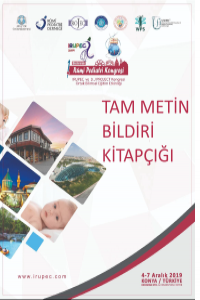Abstract
DiGeorge syndrome is a congenital genetic disorder characterized by a variety of findings, including cardiac defects, craniofacial dysmorphism, cleft palate, thymic hypoplasia and hypoparathyroidism. This rare syndrome is mainly caused due to deletion of chromosome 22q11.2. The patients with this condition are prone to develop infections due to poor T-cell formation and function. DiGeorge syndrome is frequently associated with interrupted aortic arch (IAA) and truncus arteriosus. Here we report a case of IAA type C associated with 22q11.2 deletion.
Case:
A 7-day-old female newborn was admitted with signs of cardiac failure and mild cyanosis. Physical examination revealed a grade 3/6 precordial systolic murmur, moderate hepatomegaly, normal peripheral pulses and facial dysmorphism. Echocardiography showed a large perimembranous ventricular septal defect (VSD), IAA (aortic interruption between the innominate artery and the left carotid artery; type C) with a wide ductus arteriosus. At day 9, she was operated for the correction of IAA and patch closure of the VSD via a median full sternotomy. Hypocalcemic convulsions caused by hypoparathyroidism occurred at day 10, requiring intravenous calcium supplementation and anticonvulsant therapy. Cytogenetic evaluation revealed chromosomal abnormality; 46,XX,del (22)(q11.2). She was diagnosed to be DiGeorge syndrome with characteristic physical features and genotypic findings. The patient was discharged at day 28 in good health. Presently, at 6th month, the child has slightly retarded growth and mild tachydyspnea. She has complained recurrent respiratory infections. She is still under follow-up of departments of pediatric cardiology, genetics, pediatric immunology, and developmental pediatrics.
Conclusion:
By this report we would like to point out that all patients with IAA who have additional features specific for 22q11.2 microdeletion syndrome should be screened for the presence of this deletion.
Keywords
References
- References 1- Celoria GC, Patton RB. Congenital absence of the aortic arch.Am. Heart J.1959;58: 407–13. 2- Rauch A, Hofbeck M, Leipold G et al. Incidence and significance of 22q11.2 hemizygosity in patients with interrupted aortic arch. Am. J. Med. Genet.1998;78: 322–31. 3- Marino B, Digilio MC, Persiani M.et al.Deletion 22q11 in patients with interrupted aortic arch. Am. J. Cardiol.1999;84:360–1. 4- Agnoletti G, Borghi A, Annecchino F. A rare form of interrupted aortic arch.Ital. Heart. J.2001;2: 228–30. 5- Fujii I, Ueno Y, Kurano R, Goto Y. Interrupted aortic arch type C associated with DiGeorge syndrome in 22q11.2 deletion: first case detected in Japan. Pediatr Int. 2005;47(6):698-700. 6- Lindsay EA. Chromosomal microdeletions: dissecting del22q11 syndrome. Nat. Rev. Genet.2001;2: 858–68. 7- Scambler PJ. The 22q11 deletion syndromes.Hum. Mol.Genet.2000;9: 2421–6. 8- Ramirez Alcantara J, Mendez MD. Interrupted Aortic Arch. StatPearls [Internet]. Treasure Island (FL): StatPearls Publishing; 2019-2019 Feb 10. 9- Hoffman JI, Kaplan S. The incidence of congenital heart disease. J. Am. Coll. Cardiol. 2002 Jun 19;39(12):1890-900. 10- McDonald-McGinn DM, Sullivan KE. Chromosome 22q11.2 deletion syndrome (DiGeorge syndrome/velocardiofacial syndrome). Medicine (Baltimore). 2011;90(1):1-18.
Abstract
References
- References 1- Celoria GC, Patton RB. Congenital absence of the aortic arch.Am. Heart J.1959;58: 407–13. 2- Rauch A, Hofbeck M, Leipold G et al. Incidence and significance of 22q11.2 hemizygosity in patients with interrupted aortic arch. Am. J. Med. Genet.1998;78: 322–31. 3- Marino B, Digilio MC, Persiani M.et al.Deletion 22q11 in patients with interrupted aortic arch. Am. J. Cardiol.1999;84:360–1. 4- Agnoletti G, Borghi A, Annecchino F. A rare form of interrupted aortic arch.Ital. Heart. J.2001;2: 228–30. 5- Fujii I, Ueno Y, Kurano R, Goto Y. Interrupted aortic arch type C associated with DiGeorge syndrome in 22q11.2 deletion: first case detected in Japan. Pediatr Int. 2005;47(6):698-700. 6- Lindsay EA. Chromosomal microdeletions: dissecting del22q11 syndrome. Nat. Rev. Genet.2001;2: 858–68. 7- Scambler PJ. The 22q11 deletion syndromes.Hum. Mol.Genet.2000;9: 2421–6. 8- Ramirez Alcantara J, Mendez MD. Interrupted Aortic Arch. StatPearls [Internet]. Treasure Island (FL): StatPearls Publishing; 2019-2019 Feb 10. 9- Hoffman JI, Kaplan S. The incidence of congenital heart disease. J. Am. Coll. Cardiol. 2002 Jun 19;39(12):1890-900. 10- McDonald-McGinn DM, Sullivan KE. Chromosome 22q11.2 deletion syndrome (DiGeorge syndrome/velocardiofacial syndrome). Medicine (Baltimore). 2011;90(1):1-18.
Details
| Primary Language | English |
|---|---|
| Subjects | Health Care Administration |
| Journal Section | Congress Proceedings |
| Authors | |
| Publication Date | December 10, 2019 |
| Acceptance Date | January 16, 2020 |
| Published in Issue | Year 2019 Volume: 7 Issue: Ek - IRUPEC 2019 Kongresi Tam Metin Bildirileri |


